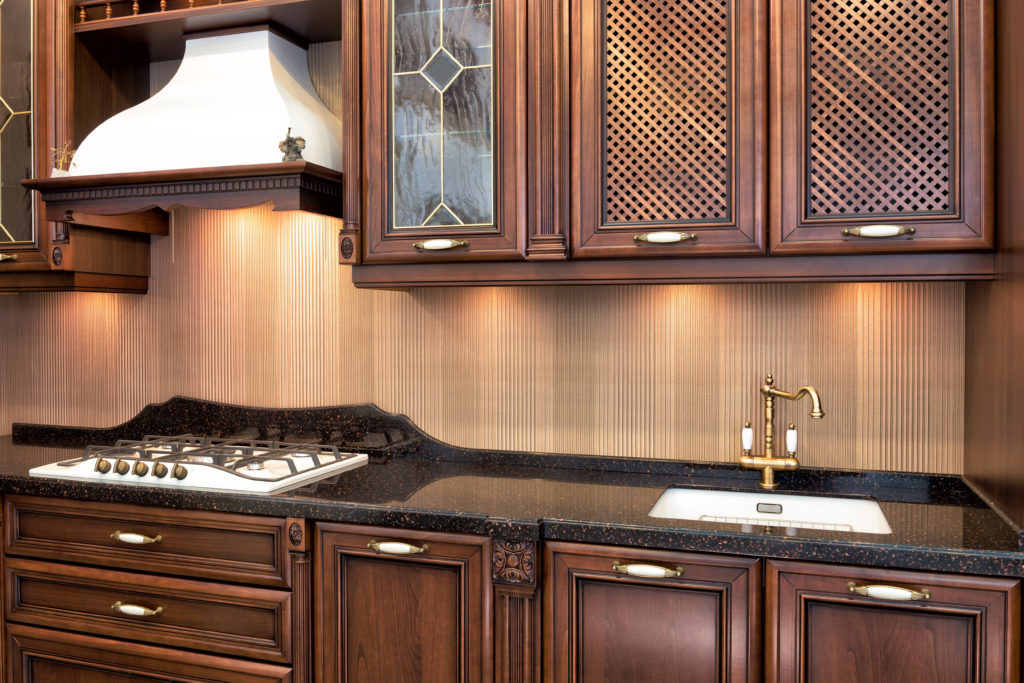
Range hoods are an essential part of your kitchen’s function—venting grease, vapors, fumes, and cooking smells up and away from your kitchen. They also provide moisture/humidity control, helping to maintain healthy indoor air quality. And, of course, there’s the fact that range hoods are required over ranges/cooktops as per kitchen building codes around the country.
Even though range hoods provide the same utilitarian function, their designs and capabilities vary widely. It’s wise to take time to select a hood that looks great—and that performs adequately for your kitchen’s size and use. And, because ductwork may need to be re-designed/installed as well, it’s important to choose your hood before remodeling or updating the kitchen.
How Much Hood Power Is Enough?
Range hood power correlates directly to range BTUs (British Thermal Unit); for every 100 BTUs of hood power, you need at least 1 CFM (Cubic Feet per Minute) of power from the hood’s fan blower. Depending on your cooking style, you may need to get a range hood that’s unique to your needs.
How Big Should It Be?
You’ve probably noticed there is a broad range of sizes—from minimalist to quite grand. While aesthetics play a role, size is also dictated by the needs of the user. For example, professional-grade hoods (popular for avid chefs and entertainers who have commercial-grade ranges) are designed to cover in excess of the range’s footprint. This is not typically the case for standard models, which mirror or may be a bit smaller than the cooktop.
Keep Sound (Sone) In Mind
The more powerful the fan blower and venting capacity, the noisier a hood vent tends to run. Hood sound levels are measured in sones—the higher the sone, the louder the fan. If you’re sound sensitive, pay attention to this number and select the most adequately powered hood with the lowest sones rating.
One sone is usually equal to the loudness of 1,000 Hz with a sound level of 40 decibels above the normal reference level. A sound with a loudness of more than four sones is usually regarded to be four times louder than the normal reference level.
Style, Types and Options
The type of range hood you choose may vary depending on your kitchen layout, size of your stove, and personal preferences. Regardless of the type of range hood you choose for your kitchen, you need to ensure it can accomplish its intended purpose and meets all your ventilation needs.
Wall-Mounted Range Hood
A wall-mounted range hood is attached to the wall above the cooking area. If you already have a cabinet in the space above the stove, it can be removed to make way for this type of range hood.
A wall-mounted range hood is installed with a chimney to help with ventilation. It also serves as a design element by adding a distinctive look to your kitchen based on the product style or brand. This type of range hood vents out smoke and other unwanted combustion products from your kitchen through an exterior wall behind them.
Under-Cabinet Range Hood
Under-cabinet range hoods are common in modern homes because of their attractive design and compact size. Just as the name suggests, this type of range hood is installed under cabinets that are directly above the cooktop.
An under-cabinet range hood can be either ducted or ductless depending on your chosen preferences. A ducted range hood is compact and works by filtering dirty air and recycling it back to your kitchen. A ductless range hood is more effective but consumes a lot of space during installation.
Island Range Hood
This type of range hood works great for an island layout since the cooktop is located in the middle of the kitchen. It is almost similar to a wall-mounted range hood in terms of design but it is suspended from the ceiling directly above your cooktop.
Instead of a duct that hides behind the hood, an island range hood has a duct in the ceiling that vents out polluted air from your kitchen. It is important to consider the manufacturer’s recommendations regarding height measurements when installing an island range hood. Some homes do not have proper clearance to vent through the ceiling. The ductwork should not end in the attic but should be able to vent air outside your home.
Cabinet Insert Hoods
A cabinet insert hood provides greater customization options for a modern kitchen. It can be installed into customized cabinets above the stovetop or cooktop. Although it is designed with basic features such as blowers, speed controls, and lighting, it does not have a complete ventilation system like other types of range hoods.
It is ideal when used as the base for a custom-designed range hood because it provides all the core features you need. It also allows you to design a ventilation system that matches the layout of your kitchen.
